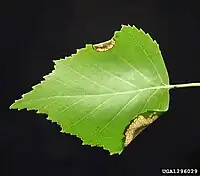| Parornix betulae | |
|---|---|
 | |
| Scientific classification | |
| Domain: | Eukaryota |
| Kingdom: | Animalia |
| Phylum: | Arthropoda |
| Class: | Insecta |
| Order: | Lepidoptera |
| Family: | Gracillariidae |
| Genus: | Parornix |
| Species: | P. betulae |
| Binomial name | |
| Parornix betulae | |
| Synonyms | |
| |
Parornix betulae is a moth of the family Gracillariidae. It is known from all of Europe (except the Iberian Peninsula, the Balkan Peninsula and the Mediterranean islands), east to Korea. It was recently reported from Canada, with records from Québec, Ontario and British Columbia.[2]


The wingspan is 9–10 mm. The head is fuscous, more or less mixed with white. Palpi white, sometimes with dark fuscous subapical ring. Forewings are grey, irrorated with dark fuscous and white ; numerous costal strigulae, a spot in middle of disc and another posteriorly, and two dorsal spots white ; a blackish apical spot ; cilia with two dark fuscous lines, tips round apex white, beneath apex with a third dark fuscous line. Hindwings are grey. The larva is whitish green ; dorsal line dark green ; head brownish ; segment 2 with four black spots.[3]
Adults are on wing in May and August.[4]
The larvae feed on Betula alleghaniensis, Betula grossa, Betula humilis, Betula obscura, Betula papyrifera, Betula pendula, Betula pubescens, Betula nana and Betula utilis. They mine the leaves of their host plant. The mine starts as an inconspicuous lower surface corridor, mainly recognisable by its brown line of frass. In the next larval stage a lower-surface blotch is made, that soon develops into a tentiform mine. The frass is deposited in a clump in a corner of the mine. After leaving the mine the larva continues feeding in a downwards folded leaf margin, that is fixed with silk.[5]
References
- ↑ Fauna Europaea
- ↑ Shared but overlooked: 30 species of Holarctic Microlepidoptera revealed by DNA barcodes and morphology
- ↑ Meyrick, E., 1895 A Handbook of British Lepidoptera MacMillan, London pdf
 This article incorporates text from this source, which is in the public domain. Keys and description
This article incorporates text from this source, which is in the public domain. Keys and description - ↑ UKmoths
- ↑ "bladmineerders.nl". Archived from the original on 2012-04-19. Retrieved 2010-11-02.